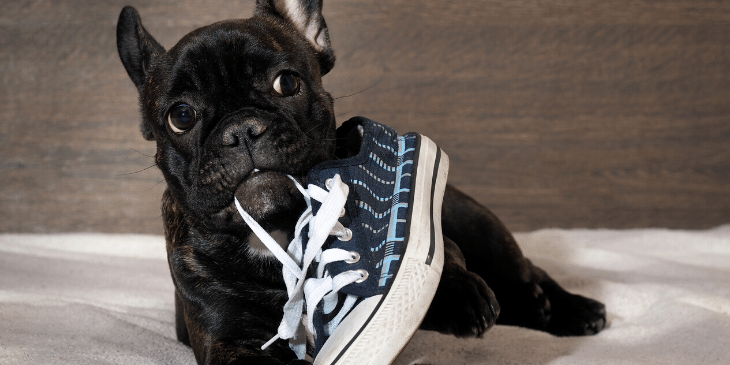7 Ways to Help a Dog with Separation Anxiety

Contents
We’ve all been there. Your baby has his head hanging, puppy eyes on full display as he watches you leave for work. It’s enough to make you feel guilty for having to pay the bills!
A dog with separation anxiety, or one who is simply bored, will express their emotional distress in a variety of ways, from barking, howling and whining to chewing up your favorite shoes… or worse.
It’s extremely stressful leaving the house every morning not knowing what kind of mess you’re going to come home to. And angry neighbors who are tired of listening to all the noise are no fun either.
Here’s the thing. Dogs are social beings. They need interaction with their pack mates (you and your family) and being home alone goes against their nature.
Dogs with separation anxiety and boredom issues are very common and figuring out how to handle it can be a real struggle for their owners. In this article, we’ll help you understand if your dog is simply bored or if you’re dealing with separation anxiety and discuss seven ways you can help.
How to Tell the Difference Between Separation Anxiety and Boredom
Telltale Signs of Boredom
Just like people, dogs can become bored if they don’t get enough mental and physical stimulation. Dogs who have exactly the same routine every day, very little exercise, and limited socialization are likely to become bored.
When a dog is bored, he will try to find ways to entertain himself, such as chewing on your stuff or barking at the neighbors to pass the time. Many owners assume a bored dog has separation anxiety or assume their dog is acting out for being left at home.
However, a dog with a simple case of boredom can easily be helped by providing additional exercise, socialization, and investing in some interactive dog toys.
The telltale signs of boredom include:
- Sporadic Barking
- Chewing
- Digging
A Dog with Separation Anxiety Has a Much Bigger Problem
A dog with separation anxiety will be much more extreme in the way they act out. They aren’t just bored; they are truly distressed when left home alone.
From the time your dog was born, he has always been in the company of his pack. In the beginning, it was his mom and littermates. As he got older, his pack became you and your family.
When he wants attention or company, he has always looked to his pack for comfort. Being home alone without his pack is extremely distressing for a dog with separation anxiety.
Sometimes, dogs with a traumatic past develop extreme separation anxiety, as well.
A dog with separation anxiety may display the following extreme behaviors:
- Frantic attempts to escape the home when you’re gone
- Peeing or pooping accidents in the house, even though they’re housebroken
- Nearly continuous howling, barking, and whining from the moment you leave
- Injuring themselves in an attempt to escape their crate, a room, or even your home
- Frantic jumping, barking, and whining when you return home
- Extremely destructive chewing or digging
- Constant noise complaints from neighbors
- Pacing the home and other signs of nervousness or distress when you’re getting ready to leave, such as heavy panting or drooling
- Clinginess or even trying to prevent you from leaving
If you’re dog only displays these behaviors when you’re getting ready to leave or when you’re not home, it’s likely that you have a dog with separation anxiety, rather than a behavior issue.
Learned Separation Anxiety
Dogs are smart. Over time, a dog may display signs of boredom or separation anxiety as a learned response.
For example, if your dog gets overly excited whenever you come home and you make a big fuss over him, he will soon learn than jumping around and barking when you come in the door will get him lots of attention. As a concerned pet parent, you may think he has separation anxiety, but what he’s really displaying is a learned response.
Why Do Dogs Develop Separation Anxiety
Sometimes, there’s no way to tell why a dog develops separation anxiety. That being said, the issue is much more common in shelter dogs and newly adopted dogs who may have had a tough history. Or, they could simply be having a hard time adjusting their new circumstances.
In some cases, a newly adopted dog may even be scared of you, but still display separation anxiety when you leave because he feels insecure when he’s alone in unfamiliar surroundings.
Some dogs with separation anxiety develop the issue when their schedule changes, the family moves to a new home, a new pet enters the home, or the family dynamics change.
Rule Out Any Medical Conditions
Before you attempt to retrain a dog with separation anxiety, make sure that any housebreaking issues aren’t the result of a medical condition. Urinary incontinence can be a symptom of urinary tract infections, bladder stones, diabetes, kidney stones, neurological problems, Cushing’s disease, and more.
Older dogs can also develop issues with bladder and sphincter control. Certain medications can also cause a problem. A trip to the vet to rule out these issues is essential before you attempt behavior modification.
7 Ways to Help a Dog with Separation Anxiety
If you believe your dog is suffering from separation anxiety, there are many things you can do to help. As an added bonus, many of these techniques will help a dog who’s simply bored as well.
1. Crate Train Your Dog When He’s a Puppy
You can do a lot to prevent separation anxiety by crate training your dog when he’s a puppy. When you first bring your new puppy home, encourage him to play and explore on his own by providing interactive toys and a safe place for him to play.
Crate training is an excellent way to teach a young puppy that it’s ok if he’s on his own for a little while. Start with short intervals and work your way up slowly. If your dog is older, you may still be able to use the crate training method, but it will take more time and patience.
Once your dog is crate trained, he will learn to think of his crate as his own personal space, even if you don’t put him in there every time you leave. Most properly crate trained dogs will learn to love their crates and sleep or hang out in them voluntarily.
That being said, some dogs just don’t take well to the crate. In that case, you might try providing a dog-safe room for your pooch to hang out in when you’re gone. Sometimes, it takes a little experimenting to find what works best for your dog. Read this article on crate training options for lots of tips and suggestions that will benefit a dog with separation anxiety or boredom issues.
2. Establish a New Morning Routine
If you’re in a rush to get out the door every morning, this one might be a struggle, but providing your dog with some exercise before you leave the house can really help.
A tired dog is a well-behaved dog, and if your dog has a bunch of nervous energy built up when you leave, you’re just asking for trouble.
Get up 30 minutes early, throw on your walking shoes and take your dog with separation anxiety for a long, brisk walk or run before you leave. Better yet, head out to the backyard for a rigorous game of fetch. Tire him out and he’ll be ready to go back to sleep when you leave.
Not only that, but you’ll be establishing a fun new social routine that your dog will love. It will help to ease the anxiety of you leaving and the exercise and fresh air will be good for both of you. With consistency, your dog will settle into a routine of exercising and then going back to sleep when you leave.
3. Hire a Dog Walker
If you can’t make it home to walk your dog at lunchtime, consider hiring a dog walker to do it for you. It will give your dog something to look forward to in the middle of the day. And, providing that additional exercise and social interaction will reduce his anxiety and have him ready to nap the afternoon away.
4. Consider Doggie Daycare
Although daycare isn’t for every dog, some dogs absolutely love it. Consider how your dog reacts in new places and around people and dogs he doesn’t know. If he’s the social type, daycare just might be the perfect solution.
Doggie daycare can get expensive if you’re doing it every day, but even once or twice a week may be enough social and playtime to keep your dog happy for the rest of the week.
5. Invest in Some Treat Puzzles and Other Interactive Toys
One of the best ways to keep a dog busy when you’re away from home is by providing treat puzzles and interactive dog toys. Chew toys are great, but they’ll only keep your dog busy for so long, and they provide no mental stimulation like treat puzzles and interactive toys do.
Provide a few interactive toys filled with your pup’s favorite treats and he may not even realize you’re gone! Just be careful to select toys that won’t present a choking hazard or other safety issues when you won’t be home to help.
6. Mental Stimulation is Just as Important as Exercise
Daily dog walks are essential for your dog’s mental and physical health, but they can become mundane if you follow the same route every day. Try to visit new places regularly so your dog can see and smell new things. Exploration is a great way to provide mental stimulation!
7. Don’t Fuss About Leaving and Coming Home
Remember the learned separation anxiety behaviors we mentioned above? Making a fuss every time you leave or come home will teach your dog that it’s something to get anxious about.
Instead, reinforce that it’s no big deal by simply coming and going without fanfare. When you get home, stay calm and ignore your dog until he’s calm as well. When you leave, simply walk out the door and skip the big goodbye those puppy eyes are begging for.
Remember, even negative attention is still attention. You’re better off ignoring the jumping and barking when you come in the door rather than trying to discipline your dog. Staying calm and patient and rewarding your dog when he’s calm as well will go a lot further.
Final Tip
Anti-anxiety medications for dogs have come a long way in recent years. If you try all of the above suggestions, or your dog is so anxious that he’s harming himself or causing extreme damage, it’s time to talk to your vet. He may be able to suggest something you can use to address your dog’s anxiety while you continue to work on training your dog with separation anxiety issues.
